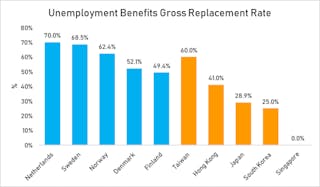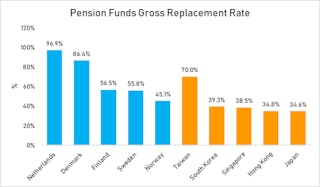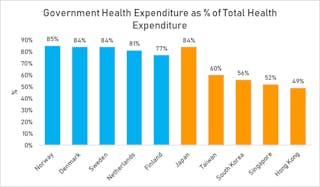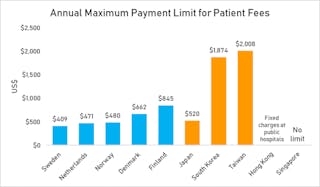What you need to know
Taiwan’s social welfare system stands out – it just doesn't feel like it because low wages make the benefits look insufficient.
This is the fourth in a 5 part series. You can start with part 1 here.
Social protections and saving graces
As touched on in part 3, Taiwan’s saving grace lies in its social welfare system.
Taiwan ranks eighth in a global list of unemployment benefit replacement rates, which compare unemployment benefits received when not working to wages earned when last employed in a given year (in this case the year 2000). The list was compiled based on underlying data for this IMF working paper and does not take into account the eligibility of recipients for unemployment benefit, the duration they are able to receive it, or the conditions attached to its distribution.
Taiwan can be said to offer adequate protection, which at 60 percent of the previous salary is just below the Netherlands’ 70 percent, Sweden’s 68.5 percent and Norway’s 62.4 percent. In general, the Nordics and the Netherlands have high replacement rates, and they also start at a high wage base.
Singapore does not have any unemployment benefits – the government has refused to consider introducing them on the basis that employers are mandated to pay laid off workers retrenchment benefits and Singapore has persistently low unemployment. Manpower Minister Lim Swee Say told Singapore’s parliament in 2016 that nine out of 10 retrenched workers receive such benefits.
Prime minister Lee Hsien Loong said at the May Day Rally in 2016: “Actually, we have something even better than unemployment insurance, because (for) unemployment insurance the worker has to pay out of his salary.” He added, “Ours is different. The scheme is not paid by the workers or the employers. It is paid by the government and the scheme is […] to help you get employed, get a job [and] upgrade yourself.” Lee was referring to the SkillsFuture scheme introduced in 2016 where Singaporeans aged 25 and above received SG$500 to attend training courses. However, this money is not given on an annual basis and Singaporeans only receive “periodic top-ups”. But early this month, it was revealed that since its launch, only 285,000 working adult Singaporeans used SkillsFuture and in 2017, only about 160,000 Singaporeans, did so. The Online Citizen calculated that this would mean that only 11.4 percent of Singaporeans have used this money over the last two years – it would be lower when accounting for only 2017. It is not known if these figures account for the money which Singaporeans were scammed of – it was later found that SG$40 million worth of fraudulent claims to SkillsFuture were made by a criminal syndicate and 4,400 individuals submitted false claims of SG$2.2 million.
But academics, economists and opposition members have been calling for unemployment benefits. In the book, “Singapore Perspectives 2012: Singapore Inclusive : Bridging Divides”, published by the Institute of Policy Studies, the authors wrote that, "within policymaking circles, it is often argued that unemployment benefits create moral hazard, [...] but even if our policymakers remain sceptical, [...] how should our social security system help workers transit between sectors as the pace of restructuring intensifies?" At a budget forum organized by the Economic Society of Singapore in 2016, Assistant Professor Giovanni Ko at Nanyang Technological University also said, “You can’t just have a push towards automation without something to help catch these people who will probably lose their jobs,” and that, “there needs to be some kind of safety net”.
OCBC Bank’s head of treasury research and strategy Selena Ling echoed: “I think if you want people to take risks, you want people to give up their bread-and-butter kind of jobs to start up companies, try new things, see the world, fail nine times before they get one right ... definitely you have to have some form of support infrastructure.”
Japan and South Korea’s unemployment benefits provide for only 28.9 percent and 25 percent of the previous salary, respectively, and in Hong Kong, it is only 41 percent.
It should be noted that in Japan, unemployment insurance is legislated at 50 percent to 80 percent of the previous salary but because there is a maximum daily limit of 7,830 yen (US$70.75) in unemployment benefits, the average gross replacement rate is therefore low in comparison with wages. Similarly, in South Korea, unemployment benefits cover 50 percent of the previous salary, and again because the maximum daily limit is only 40,000 won (US$37.48), the average gross replacement rate is low as well.

On pension adequacy, Taiwan also does well – the gross pension replacement rate stands at 70 percent, coming third after the Netherlands and Denmark, at 96.9 percent and 86.4 percent, respectively.

Source: OECD (2017 report), Taiwan; OECD (2009 report), Hong Kong and Singapore: OECD (2013 report).
However, there is a wide disparity in the pension payments received by Taiwanese workers. Before last year’s pension reform, the average monthly pension for public school teachers was NT$68,025 (US$2,315), NT$49,379 for military personnel and NT$56,383 for civil servants. However, for private sector employees, private school teachers only received NT$17,223 – just a quarter to a third of what their public sector counterparts received – while employees covered by labor insurance received only NT$16,179 and farmers received a paltry NT$7,256.
Moreover, 46 percent of retirees actually received an average pension of only NT$3,791 because they have not worked enough years to be eligible for pension payments. After the pension reform, the replacement rates for public teachers have decreased from 75 percent to 60 percent – still high – with a base pension payment amount of NT$32,160, which means that public school teachers will still receive at least twice as much as their private sector counterparts.
In addition, public sector workers already earn higher wages, a minimum of NT$29,345 as compared to NT$22,000 for private sector workers. Private sector workers in Taiwan are short-changed in terms of their wages and benefits.
The other East Asian countries fared poorly in their pension adequacy, with replacement rates at between 34.6 percent (Japan) and 39.3 percent (South Korea). Singapore’s and Hong Kong’s replacement rates were 38.5 percent and 34.8 percent, respectively. In addition to Hong Kong's Mandatory Provident Fund (MPF) public pension scheme, the government also provides various social security schemes for the elderly based on their income level: 13 percent of the elderly received a monthly payment of HK$5,548 (US$710) in 2015, 37 percent received HK$2,390 and 19 percent received HK$1,235.
The amounts are actually low in comparison to the cost of living and do not do much to increase the replacement rates, but if you think these are low, look at what Singapore provides – only between SG$100 (US$76) and SG$250 a month, and it is only given to the bottom 20 percent of retirees, who have to meet stringent criteria. Retirees in Singapore are also not guaranteed a minimum pension amount or a minimum pension payment as a percentage of their previous wage as the other countries do. In 2014, the median pension payment from Singapore’s Central Provident Fund (CPF) was only SG$394, as compared to the median wage of SG$3,276 in that year, making up only 12 percent of the median wage.
The Singapore government transfers Singaporeans’ CPF pension funds into the government investment firm GIC Private Limited. The fund claims on its website that it “receives funds from the government […] without regard to the sources” while the Singapore government claims that the funds from the CPF are “comingled” with other funds such as government surpluses and land sales, and ultimately transferred to GIC for management.
The other government investment firm, Temasek Holdings, clearly states that “Temasek does not manage CPF savings.” There is little transparency in how the GIC and Temasek are being managed, and the size of the funds managed by the GIC are not even published. In 2015, Nominated Member of Parliament Chia Yong Yong said that she was “not entirely sure” if Singaporeans “have the right to spend [their CPF monies]” because “at the end of the day […] I am not the only person contributing to that fund, I cannot be the only person to call the shots as to how I'm going to spend it.”
Prime Minister Lee later said that Chia “made an excellent speech about the CPF” about the “broader perspective: whether it is right to think of the CPF as “our money”, to be spent solely as we choose.”
“I am glad that she did, and to such good effect,” Lee added.
Singaporeans have often complained that their CPF monies are trapped inside the government’s coffers and it has become commonplace to hear Singaporeans lament that the “CPF is not my money.”
Healthcare
On health expenditure, the Taiwanese government’s contribution of 60 percent of total health expenditure again puts Taiwan ahead of Singapore and Hong Kong, where the governments only spend 52 percent and 49 percent, respectively. However, Taiwan is still some way off from the governments of the Nordics, the Netherlands and Japan, which spend between 77 percent and 85 percent on healthcare.

Source (data from latest year): World Health Organisation, Taiwan: Ministry of Health and Welfare Taiwan, Hong Kong: Food and Health Bureau The Government of the Hong Kong Special Administrative Region.
Also in the Nordics, the Netherlands and Japan, there is an annual maximum payment limit that citizens need to pay when they seek healthcare, or a limit to the co-payment. Citizens in these countries only need to pay a maximum of between US$409 (Sweden: 3,300 krona) and US$845 (Finland: €691) in a year. It is higher in South Korea, where the limit is set at 2 million won (US$1,874) for the bottom 50 percent, 3 million won for the middle 30 percent, and 4 million won for upper 20 percent.
There is also an annual limit in Taiwan, but the cap of NT$59,000 (US$2,008) pertains to each condition, though it is understood that patients seldom have to pay this maximum amount. Patients pay as low as NT$50 (US$1.70) to see a general practitioner (GP) or NT$150 (US$5.10) for emergency care at a district hospital.

Source (data from latest year): Norway: The Local Norway, Denmark: Danish Medicines Agency, Sweden: The Newbie Guide to Sweden, Finland: City of Helsinki, The Netherlands: Zilveren Kruis, Japan: Tokyo Securities Industry Health Insurance Society, South Korea: National Health Insurance Service South Korea, Taiwan: National Health Insurance Administration, ROC, Hong Kong: Hospital Authority.
In Hong Kong, there is no annual limit set, but the government mandates specific charges that patients only need to pay when they seek healthcare at public hospitals. These charges are relatively low, ranging from HK$50 (US$6.40) for general outpatient services to HK$180 (US$23) per attendance to the Accident and Emergency.
Again, Singapore stands out for not having such protections – there is no annual payment limit. In the GP Fee Survey in 2013 published last year by the Singapore Family Physician journal, it was found that the median consultation fee was SG$35 (average of SG$40) with fees going up to as high as SG$100 (US$75.70).
Citizens have been known to pay astronomical amounts for healthcare – in fact, in 2012, it was found that 2,400 Singaporeans had to pay more than SG$10,000 (US$7,570) for their hospital bills. A study by Associate Professor Tilak Abeysinghe and then-PhD student Himani Aggarwal in 2014 also showed that as early as 2007, of 30,192 cases of elderly patients hospitalized at a public hospital, there were seven cases where the net hospital bill after government subsidies exceeded SG$100,000 (US$75,670), where the highest was SG$207,741 (US$157,259). In fact, Singaporeans have been known to “choose death over dialysis when their kidneys fail,” one reason being that dialysis is too expensive. It is preposterous that whereas other countries set a limit as to how much citizens have to pay for healthcare, the Singapore government instead sets a limit as to how much citizens' can claim for healthcare.
In contrast, it is free for citizens to see a GP in Finland, Denmark and the Netherlands. In Sweden, it is between 100 krona (US$12.39) and 300 krona (US$37.16), and between 152 krone (US$19.32) and 257 krone (US$32.67) in Norway. In Taiwan, it is only NTS$50 (US$1.70). In Singapore, median and average consultation fees in 2013 were SG$35 (US$26.49) and SG$40 (US$30.27), respectively, but can go as high as SG$100 (US$76).
In Japan, people who go to the GP only need to pay 20 to 30 percent of the costs, while in South Korea, it is 30 percent. In Singapore, the average citizen stumps up the full cost.
In almost all these countries, there is a maximum limit for how much citizens need to pay for patient fees in a year, but again, there is no such ceiling in Singapore.
A Lancet study has shown that high co-payments and hospital bills increase “potentially avoidable hospital admissions due to worsening of the condition, or emergency visits to obtain medication in acute episodes in patients with chronic diseases. Co-payments reduce demand for preventive services, because people tend to overestimate present costs and underestimate future health benefits.” This results in patients still having to go to hospital and pay even more than they would initially.
Unless they choose to die – which some Singaporeans have opted to do.
This could be why Singaporeans have developed a "kiasu" and "kiasee," or fight or die, attitude. But this has created a self-centered culture – studies have shown that given Singapore is the most unequal country among the developed nations, Singaporeans are also less trusting towards one another and the level of self-enhancement – where people believe that they are better than someone else – is also the highest among developed nations. Social mobility in Singapore is impeded because of the city state’s unequal social and economic structure.
On the other hand, even though wages in Taiwan are the lowest in this comparison, the country in fact offers a solid social safety net – even though it might not seem so to some Taiwanese. By most metrics, Taiwan’s social welfare system can be considered a strong one – it just does not feel like it because low wages make the benefits look insufficient.
It should also be noted, however, that Taiwan's government pays for only 60 percent of health expenditure, which compared to other developed countries, is relatively low. As such, there is room for the government to increase spending to between 70 and 85 percent, so that the quality of Taiwan's healthcare system can be maintained, and is not compromised by unnecessary cost-cutting measures. As such, instead of reducing the top rates of income tax, the Taiwan government would do better to redistribute the budget to improving healthcare standards. This could begin with improving the quality of life of healthcare workers by hiring more of them – Taiwan already has the lowest physician density among the high-income countries – tied with Singapore and Hong Kong. Their governments spend the lowest among the developed countries on healthcare.

Source (data from latest year): World Economic Forum, Hong Kong: Department of Health The Government of the Hong Kong Special Administrative Region.
On paper, Taiwan stands out as a place that protects its poor and sick. That's a saving grace, at least.
Tomorrow: Part 5: Equality and the future
Editor: David Green



